Manas National Park is located in the western part of Assam in northeast India (90o 55.65' East 26o 43.13' North). The area of Manas, which is around 50,000 hectares, spreads across the five districts of Kokrajhar, Chirang, Baksa, Udalguri and Darrang. The national park is divided into three administrative ranges—the western range at Panbari, the central range at Bansbari and the eastern range at Bhuiyanpara. Manas National Park is so named because of the River Manas that passes through it. The name ‘Manas’ is believed to have originated from the Hindu serpent goddess Manasa (Manaxa in Axomiya). The Beki and the Hakua are other important distributaries flowing through the park. Manas National Park shares the international border with Bhutan and is contiguous with the Royal Manas National Park in Bhutan. The 102,300 hectares reserve on the Bhutanese side provides a contiguous habitat for the movement of fauna, making this landscape an important area in terms of biological conservation.
According to a study by the Forest Survey of India, there are about 60 species of mammals, 327 species of birds, 42 species of reptiles, 7 species of amphibians, 5 species of fish and around 103 species of invertebrates that have been identified in the Manas. Among these, 21 species are listed as endangered, including the one-horned rhinoceros, Bengal florican, Asian elephant, sloth bear, hoolock gibbon, golden langur, clouded leopard and tiger. Two species, the hispid hare and the pygmy hog, are endemic to the reserve. Black leopard has also been recorded in Manas.
Apart from being a National Park, Manas also has the unique distinction of being a World Heritage site, a Tiger Reserve, a Biosphere Reserve, and a Wildlife Sanctuary at the same time. While this sounds impressive on paper, in reality, it adds layers of bureaucratic complications to administering and maintaining the wildlife area. Currently, Manas falls under the Bodoland Territorial Council (BTC) area. The landscapes of Manas-Pakke-Namdapha and the Royal Manas National park in Bhutan along with the forests of Myanmar provide perhaps the largest contiguous area in terms of habitat for tigers and other large mammals (Ghosh 2013).
Northeast India lies at the crossroads of the Himalayan and Indo-Malayan biodiversity hotspot. As a result, it boasts the highest diversities of bird species in India. Being a part of this region, Manas has a wide variation of elevations to its credit. Habitats in Manas are typically grasslands and tracts of semi-evergreen forests. This unique combination of habitats makes it a biodiversity hotspot.
Birds can be classified into five dietary guilds: frugivores, nectarivores, granivores, insectivores and omnivores. They can be further classified according to their habitats, namely, terrestrial (species that forage primarily on the ground), understory (species that forage mostly within five metres from the ground), undergrowth (species that forage up to three metres above ground), midstory (species that forage above five metres but below the canopy) and canopy (species that forage in the tree canopy). Some of the world’s most endangered birds are found in Manas. The elusive Bengal florican (Houbaropsis bengalensis) survives in good numbers in Manas, one of the last remaining habitats of this bird. Greater and lesser adjutant storks are a common site along swampy areas. Other notable residents that are also of conservation concern include the rufous-necked hornbill (Aceros nipalensis), great hornbill, grey-crowned prinia (Prinia cinereocapilla), bristled grassbird (Chaetornis striata), marsh babbler (Pellorneum palustre), Jerdon's babbler (Chrysomma altirostre), slender-billed babbler (Turdoides longirostris) and black-breasted parrotbill (Paradoxornis flavirostris).
Passage migrants to Manas which are of conservation concern are the white-throated bushchat, slender-billed vulture (Gyps tenuirostrisi), Amur falcon and lesser kestrel (Falco naumanni).
Bird diversity
A few notable genera of birds found in Manas are listed below:
- Hawks, kites, eagles, harriers, bustards and vultures
- Bustard quails and buttonquails
- Curlews, sandpipers and snipes
- Pigeons and doves
- Parakeets
- Cuckoos, malkohas, coucals
- Swifts, treeswifts and trogons
- Swallows and martins
- Shrikes
- Swallow Shrikes and wood swallows
- Fairy bluebirds and leafbirds
- Babblers
- Monals
- Flycatchers
- Warblers
- Thrushes and chats
- Pipits and wagtails
- Herons, egrets and bitterns
- Pelican
- Storks
- Ibises and spoonbills
- Buntings
Threats to birds
The most common threat to birds in Manas is habitat loss and degradation. Large-scale destruction of habitat is seen to be common because of conversion to agriculture. While some birds survive well in a matrix of agriculture and grasslands, there are some specialist species that are not able to survive and breed well in open agricultural fields. One such example from Manas is the Bengal florican. This bird seems to be doing well in terms of numbers (about 80 at last count) but its grassland habitats are continually being converted to agricultural fields.
Wetland and riverine habitats in Manas are home to a wide variety of waders, lapwings, cormorants, coots and migratory water fowl like bar-headed geese. Other common species seen in these areas are storks, egrets and jacanas. Red-wattled lapwings and yellow-wattled lapwings are best sighted here. Major threats to riverine birds are silting and construction activities. Illegal sand mining along shallow river beds destroys large sand bars that are ideal feeding and nesting grounds for some of these waterfowl. Changing river courses also make the riparian habitats prone to quick changes making this type of habitat very volatile.
Tropical moist deciduous forests are characterized by the presence of broad-leaved trees such as teak and sal. The undergrowth is an evergreen layer consisting of bamboo and shrubs. These habitats are vulnerable to logging and firewood collection. Illegal logging at industrial scales targetting high value trees like sal and teak make deciduous habitats prone to disturbances. Clearing of the understory poses a threat to understory birds that prefer bamboo bushes.
Tropical semi-evergreen forests are wetter than deciduous forests and typically consist of both deciduous and evergreen trees. These habitats are mainly dominated by large trees belonging to the Lauraceae, Meliaceae and Myristicaceae families. The western part of Manas, including the Ultapani area, fall under this type of habitat. They are home to charismatic species of hornbills, including the great hornbill (Buceros bicornis) and rufous-necked hornbill (Aceros nipalensis). Out of the nine species of hornbills found in India, five are found in northeast India. The great hornbill and rufous-necked hornbill have been classified as birds of conservation concern by the International Union of Conservation of Nature (IUCN).
Some birds are generalists and can thrive in human-modified landscapes as well. Lesser adjutant storks, egrets and ibises are commonly seen in rice fields and near villages. These birds have learnt to survive well in these habitats. However rapid industrialization and urbanization has led to shrinkage of their habitats or complete disappearance of such areas.
Conclusion
Eco-tourism activities and eco-development initiatives taken up by the Forest Department and non-government organisations in the fringe villages of Manas National Park aim to bolster tourism and revive the past glory of Manas, as well as provide livelihood opportunities to local people. The Manas-Maozigendri Ecotourism Society is one such organization which aims to protect the habitats of the elusive white-bellied heron. With initiatives of this nature, Manas has the potential to become a thriving ecosystem for birds, mammals and people.
Works consulted
Choudhury, Anwaruddin. 2006. Birds of Manas National Park. Guwahati: Gibbon Books & Rhino Foundation.
Ghosh, Sonali. 2013. ‘Habitat Suitability for Tigers (Panthera tigris) in the Indo Bhutan Manas Tiger Conservation Landscape’. PhD Thesis. Aberystwyth University, UK.
Grimmett, Richard, Carol Inskipp and Tim Inskipp. 2001. Pocket Guide to the Birds of the Indian Subcontinent. London: Christopher Helm.
Forest Survey of India. 2006. ‘Forest Cover in Tiger Reserves of India. Status and Changes’. Ministry of Environment and Forests, Government of India.













